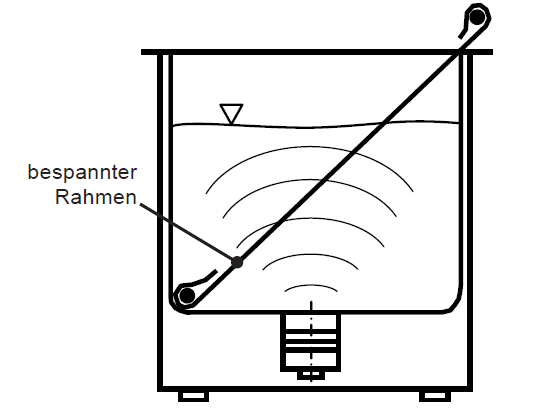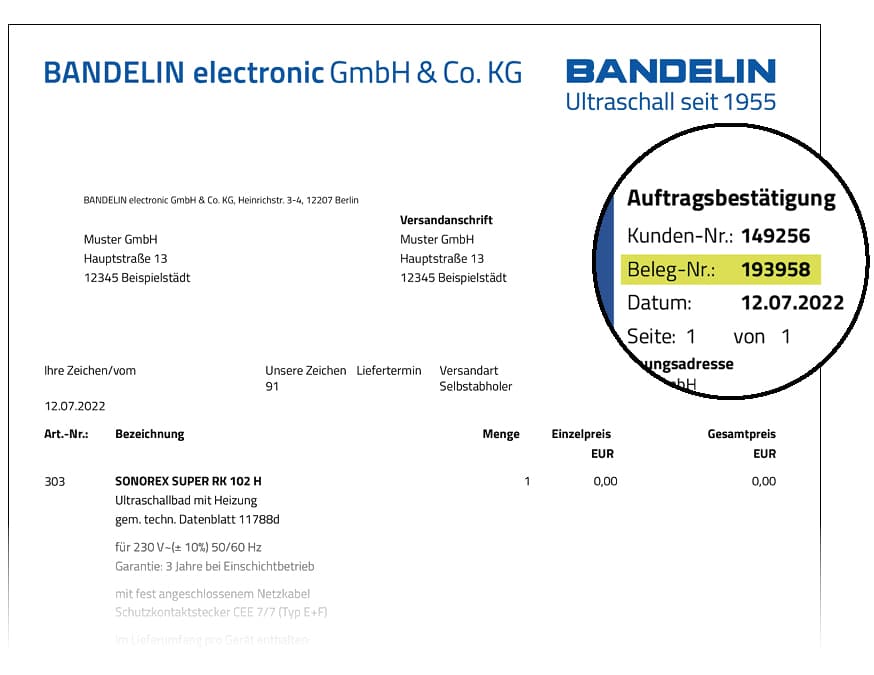Subtotal: 5.407,00 €
plus Shipping costs
Functional test of an ultrasonic bath
For the functional test of an ultrasonic bath, the foil test is recommended - at initial commissioning, then at regular intervals (e.g. ¼-yearly). The frequency of the test is the responsibility of the user. The foil test is a simple procedure for displaying the intensity and distribution of cavitation in an ultrasonic bath. For this purpose, an aluminium foil stretched on a foil test frame is inserted. This is perforated or destroyed by cavitation to a certain degree depending on the sonication time.
For the reproducibility of the test results, it is important that the test conditions are always the same:
- Filling the oscillating tank up to the filling level marking
- Temperature of the sonication fluid
- degassing time
- Positioning the frame
- Film type (brand, thickness)
- sonication duration
- Type and concentration of the ultrasound preparation
Carrying out the foil test


Folio Test Documentation Sheet
The BANDELIN Foil test documentation sheet facilitates the documentation of the functional test of an ultrasonic bath
Liquid for the foil test:
In order to obtain sufficiently strong cavitation, the interfacial tension of the water used must also be reduced for the foil test with the help of preparations containing surfactants.
We recommend the following ultrasound preparations:
TICKOPUR R 33, TICKOPUR R 30, TICKOPUR TR 7,
TICKOMED 1, STAMMOPUR R, STAMMOPUR DR 8
If none of these preparations is available, a neutral or mildly alkaline preparation that does not destroy aluminium should be used. The preparation must be approved by the manufacturer for use in the ultrasonic bath.
Test result and documentation:
If the test conditions are always the same, the test result is to be assessed according to the perforated area of the films. The perforated areas of the films should always have approximately the same extension and distribution - they are never congruent.
Regular foil tests are the only way to ensure constant process monitoring, e.g. for the reprocessing of medical devices.
The slides can also be archived in a suitable manner (scan, photo, etc.). This makes it possible to compare the slides at any time.
As an alternative to the foil test, the hydroacoustic measurement method according to
IEC TS 63001
Further explanations of this measuring method can be found at cavispector.com.
Example application in the video
We have put together an overview of sample cleanings for you to carry out an optimal US cleaning.
For every application the right
excl. 19 % VAT, plus. ShippingStandard shipping Germany:
up to 30 kg: 6,90 EUR;
30-50 kg: 49,00 EUR;
from 50 kg: 99,00 EUR;
Hazardous goods shipping Germany:
plus 11,50EUR
(Prices only for Germany and traders)
excl. 19 % VAT, plus. ShippingStandard shipping Germany:
up to 30 kg: 6,90 EUR;
30-50 kg: 49,00 EUR;
from 50 kg: 99,00 EUR;
Hazardous goods shipping Germany:
plus 11,50EUR
(Prices only for Germany and traders)
excl. 19 % VAT, plus. ShippingStandard shipping Germany:
up to 30 kg: 6,90 EUR;
30-50 kg: 49,00 EUR;
from 50 kg: 99,00 EUR;
Hazardous goods shipping Germany:
plus 11,50EUR
(Prices only for Germany and traders)
excl. 19 % VAT, plus. ShippingStandard shipping Germany:
up to 30 kg: 6,90 EUR;
30-50 kg: 49,00 EUR;
from 50 kg: 99,00 EUR;
Hazardous goods shipping Germany:
plus 11,50EUR
(Prices only for Germany and traders)
excl. 19 % VAT, plus. ShippingStandard shipping Germany:
up to 30 kg: 6,90 EUR;
30-50 kg: 49,00 EUR;
from 50 kg: 99,00 EUR;
Hazardous goods shipping Germany:
plus 11,50EUR
(Prices only for Germany and traders)
excl. 19 % VAT, plus. ShippingStandard shipping Germany:
up to 30 kg: 6,90 EUR;
30-50 kg: 49,00 EUR;
from 50 kg: 99,00 EUR;
Hazardous goods shipping Germany:
plus 11,50EUR
(Prices only for Germany and traders)
excl. 19 % VAT, plus. ShippingStandard shipping Germany:
up to 30 kg: 6,90 EUR;
30-50 kg: 49,00 EUR;
from 50 kg: 99,00 EUR;
Hazardous goods shipping Germany:
plus 11,50EUR
(Prices only for Germany and traders)
excl. 19 % VAT, plus. ShippingStandard shipping Germany:
up to 30 kg: 6,90 EUR;
30-50 kg: 49,00 EUR;
from 50 kg: 99,00 EUR;
Hazardous goods shipping Germany:
plus 11,50EUR
(Prices only for Germany and traders)
excl. 19 % VAT, plus. ShippingStandard shipping Germany:
up to 30 kg: 6,90 EUR;
30-50 kg: 49,00 EUR;
from 50 kg: 99,00 EUR;
Hazardous goods shipping Germany:
plus 11,50EUR
(Prices only for Germany and traders)
excl. 19 % VAT, plus. ShippingStandard shipping Germany:
up to 30 kg: 6,90 EUR;
30-50 kg: 49,00 EUR;
from 50 kg: 99,00 EUR;
Hazardous goods shipping Germany:
plus 11,50EUR
(Prices only for Germany and traders)
excl. 19 % VAT, plus. ShippingStandard shipping Germany:
up to 30 kg: 6,90 EUR;
30-50 kg: 49,00 EUR;
from 50 kg: 99,00 EUR;
Hazardous goods shipping Germany:
plus 11,50EUR
(Prices only for Germany and traders)
excl. 19 % VAT, plus. ShippingStandard shipping Germany:
up to 30 kg: 6,90 EUR;
30-50 kg: 49,00 EUR;
from 50 kg: 99,00 EUR;
Hazardous goods shipping Germany:
plus 11,50EUR
(Prices only for Germany and traders)
excl. 19 % VAT, plus. ShippingStandard shipping Germany:
up to 30 kg: 6,90 EUR;
30-50 kg: 49,00 EUR;
from 50 kg: 99,00 EUR;
Hazardous goods shipping Germany:
plus 11,50EUR
(Prices only for Germany and traders)
excl. 19 % VAT, plus. ShippingStandard shipping Germany:
up to 30 kg: 6,90 EUR;
30-50 kg: 49,00 EUR;
from 50 kg: 99,00 EUR;
Hazardous goods shipping Germany:
plus 11,50EUR
(Prices only for Germany and traders)
excl. 19 % VAT, plus. ShippingStandard shipping Germany:
up to 30 kg: 6,90 EUR;
30-50 kg: 49,00 EUR;
from 50 kg: 99,00 EUR;
Hazardous goods shipping Germany:
plus 11,50EUR
(Prices only for Germany and traders)
Discover more

Further practical tips and assistance for our ultrasonic baths and their use can be found in our Knowledge Base under Practical Tips. Of course, you are also welcome to contact us if you have any questions regarding the devices or their use.
BANDELIN electronic GmbH & Co. KG
Heinrichstraße 3-4
12207 Berlin, Germany
info@bandelin.com
Tel: +49 30 76880-0
Fax: +49 30 7734699

This will close in 0 seconds
| Cookie | Dauer | Beschreibung |
|---|---|---|
| cookielawinfo-checkbox-analytics | 11 months | This cookie is set by GDPR Cookie Consent plugin. The cookie is used to store the user consent for the cookies in the category "Analytics". |
| cookielawinfo-checkbox-functional | 11 months | The cookie is set by GDPR cookie consent to record the user consent for the cookies in the category "Functional". |
| cookielawinfo-checkbox-necessary | 11 months | This cookie is set by GDPR Cookie Consent plugin. The cookie is used to store the user consent for the cookies in the category "Necessary". |
| cookielawinfo-checkbox-others | 11 months | This cookie is set by GDPR Cookie Consent plugin. The cookie is used to store the user consent for the cookies in the category "Other. |
| cookielawinfo-checkbox-performance | 11 months | This cookie is set by GDPR Cookie Consent plugin. The cookie is used to store the user consent for the cookies in the category "Performance". |
| viewed_cookie_policy | 11 months | The cookie is set by the GDPR Cookie Consent plugin and is used to store whether or not user has consented to the use of cookies. It does not store any personal data. |